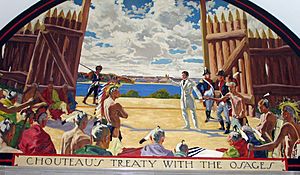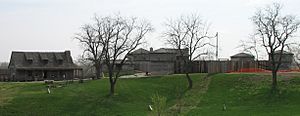Treaty of Fort Clark facts for kids
The Treaty of Fort Clark (also known as the Treaty with the Osage or the Osage Treaty) was an important agreement signed at Fort Osage (which was then called Fort Clark) on November 10, 1808. It was officially approved on April 28, 1810. In this treaty, the Osage Nation agreed to give up a large area of land to the United States. This land was located east of the fort in what is now Missouri and Arkansas, north of the Arkansas River.
This treaty, along with the Treaty of St. Louis (where the Sac and Fox tribes gave up land in Missouri, Illinois, and Wisconsin), were the first big agreements made after the United States bought the Louisiana Purchase. Many tribes were not happy with these treaties. Because of this, some of them chose to support the British during the War of 1812. After that war, a man named John C. Sullivan surveyed the land in 1816. He adjusted the boundary line, moving it west to the mouth of the Kansas River. This new line was called the Indian Boundary Line. Later, in 1830, the Indian Removal Act led to many tribes being moved to lands west and south of this line.
Contents
How the Treaty Came About
When explorers Lewis and Clark started their journey up the Missouri River in 1804, a fur trader named Pierre Chouteau from St. Louis helped. He took some Osage chiefs to meet President Thomas Jefferson. Jefferson promised to open a special government trading post, also called a "factory." At this factory, the Osage could sell their goods at fair prices set by the government. This was supposed to stop individual traders from taking advantage of them. The trading post would also have a blacksmith to make tools for the Native Americans.
In early 1808, Meriwether Lewis led a group to the spot where Fort Osage was built, near Sibley, Missouri. They built the fort on a high cliff overlooking the Missouri River. Pierre Chouteau then traveled about 150 miles south to Neosho, Missouri, where the main Osage village was located on the Osage River. He brought the Osage chiefs back to Fort Osage, where they were shown the terms of the treaty.
What the Treaty Said
Land Given Up
The treaty clearly stated which lands the Osage Nation was giving up. It described the boundary line:
"Starting at Fort Clark, on the Missouri River, five miles above Fire Prairie, and running straight south to the Arkansas River. Then, following the Arkansas River down to the Mississippi River. We, the chiefs and warriors of the Great and Little Osage, give up all the lands that are east of this line, and north of the southern bank of the Arkansas River, and all lands north of the Missouri River. We also give up a piece of land two leagues square (about 6 miles by 6 miles) around Fort Clark. The President of the United States will decide exactly how this square will be laid out."
Payments to the Osage
According to Article V of the treaty, the Osage were promised yearly payments from the United States:
"The Great Osage nation will receive eight hundred dollars each year, and the Little Osage nation will receive four hundred dollars each year." (In today's money, $800 would be about $13,559, and $400 would be about $6,780.)
Where the Osage Could Hunt
Article VIII of the treaty also said that Osage people who wanted to live near Fort Clark and follow the treaty rules would be allowed to hunt on their usual lands west of the new boundary line. This was allowed as long as those lands were not already being used by other friendly Native American tribes. They could also hunt on other lands in the Louisiana Territory that were not yet settled by white people, until the United States decided to give those lands to other tribes.
After the Treaty
Right after the treaty was signed, some members of the Osage tribe protested. They claimed that not all the right leaders had signed the document. Most of the Osage did not move to Fort Osage. Instead, they stayed in their home village in Neosho. As mentioned earlier, some Osage warriors chose to fight alongside the British during the War of 1812. After that war ended, the Osage were called to Portage Des Sioux, Missouri. There, in 1815, they confirmed the treaty again as part of the Treaties of Portage des Sioux.
Images for kids
-
Mural depicting the treaty from the Missouri State Capitol




